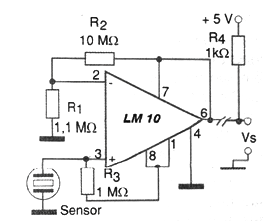The amplifier shown in the figure is indicated for operation with resistive transducers such as pressure, temperature, or light sensors. This circuit, like the others, is based on an operational amplifier with exceptional characteristics from National, which is the LM10. This operational amplifier can operate with voltages from as little as 1.1 V. The LM10 uses PNP transistors with 100 times gain input with a current of only 1 uA, as this type of component allows a better match than when uses NPN transistors. This amplifier is basically indicated to operate as a comparator, but its configuration in applications that require linear operation is also possible. In this modality, the remote amplifiers stand out, in which the power supply to the operator itself can be done through the signal cable, as in this case. The use of amplifiers on the signal source and not on arrival eliminates the problems of capacitances, inductances, noise, and others that can degrade the quality of the signal and affect the accuracy of the system. Resistors R1 and R2 depend on both the sensor characteristics and the desired gain. Thus, R1 must have the same order of magnitude as the sensor in its condition of center of scale. The resistor R2, on the other hand, must have values that together with R1 will determine the gain of the circuit. The load resistance depends on the interfaced circuit. Note that this circuit can be used to monitor a remote sensor via a twisted cable with power supplied to the receiver side.




